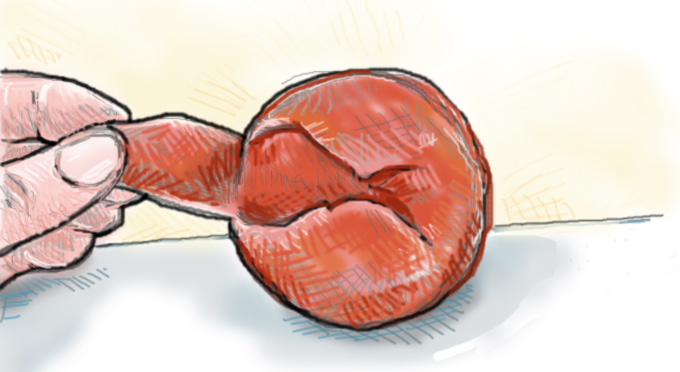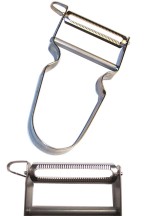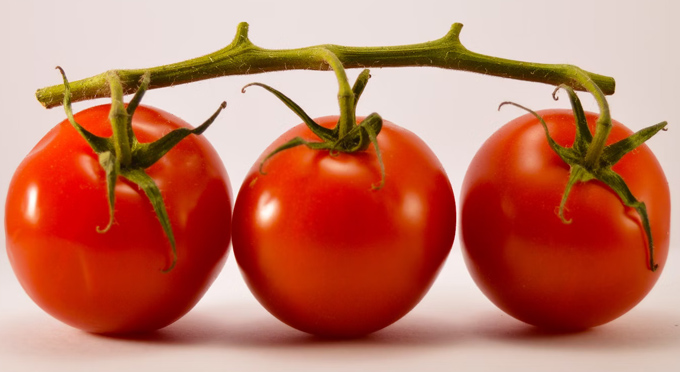 Removing the outer skin is important when cooking with tomatoes. If left in place, they will eventually separate to ruin your sauce, chili or stew by adding a stringy texture. If you try to use a regular peeler, the smooth skin and squishy texture will make it extremely difficult. Most times the tool will glide right over the surface without actually cutting, and if you apply pressure, it may smash the flesh, and make a mess. In order to remove the skin without ruining the fruit, you need to release the bond that the inner meat has with the skin, or you need to use a better tool to remove the skin without effort.
Removing the outer skin is important when cooking with tomatoes. If left in place, they will eventually separate to ruin your sauce, chili or stew by adding a stringy texture. If you try to use a regular peeler, the smooth skin and squishy texture will make it extremely difficult. Most times the tool will glide right over the surface without actually cutting, and if you apply pressure, it may smash the flesh, and make a mess. In order to remove the skin without ruining the fruit, you need to release the bond that the inner meat has with the skin, or you need to use a better tool to remove the skin without effort.
There are several ways to prepare the skin and make it easy to peel off, and we will provide the steps for these below. Some people also use a knife to do it by hand, but that can be difficult and wasteful. After providing instructions on how to do it by boiling, cooking or bruising, we will show you how a specialized peeler can do the job in less time, and with less effort.
Follow the steps for whichever method you like best to complete this task with stuff you already have at home, or get an affordable tool to save yourself time, effort and frustration.
Why Peel Tomatoes?
It’s important to note that not all recipes require peeled tomatoes, and there’s no universal rule mandating that tomatoes must be peeled. The choice to peel tomatoes depends on personal preference, the type of dish you’re preparing, and the desired texture and appearance. If you enjoy the flavor and texture of tomato skins or prefer the convenience of leaving them on, there’s no need to peel them in your cooking. Ultimately, whether to peel tomatoes or not is a matter of taste and the specific requirements of your recipe. Check the list below to see the main reasons why you may want to remove the outer layer from tomatoes while cooking:
- Texture: Tomato skins can sometimes be tough or have a slightly bitter taste, which can affect the overall texture and flavor of dishes. Removing the skin can lead to a smoother and more pleasing texture in dishes like sauces, soups, and salsas.
- Aesthetics: In certain dishes, like tomato sauce or tomato bisque, a smooth and uniform appearance is desired. Tomato skins can create small specks or uneven textures in these dishes, which some people find less visually appealing.
- Consistency: When making sauces or purees, removing the skin ensures a consistent texture throughout the dish. This is especially important in professional kitchens or when presentation is a top priority.
- Allergies and Sensitivities: Some individuals have sensitivities or allergies to tomato skins. Peeling the tomatoes can make dishes more accessible for people with these sensitivities.
- Flavor: In some recipes, like certain fruit salads or fresh salsas, the skin of the tomato may not blend well with the other ingredients. Removing the skin allows the tomato’s flavor to integrate more harmoniously with the other components.
- Canning and Preserving: When canning tomatoes or making tomato-based preserves, peeling is often recommended. It can help ensure the quality and safety of the preserved product.
- Textural Contrast: In specific dishes, chefs may choose to peel tomatoes to create a contrast in texture. For example, a tomato salad with both peeled and unpeeled tomatoes can provide a mix of textures.
Why Are Tomatoes So Hard To Peel?
Besides the smooth slippery skin that seems impossible to dig into with a regular vegetable peeler, there are many other reasons that make tomatoes difficult to peel. They can also be challenging to peel because of the structure of their skin and the way it’s attached to the flesh, but there are several other factors that contribute to the difficulty of peeling tomatoes too. When faced with this task, many people try to avoid the job, or skip the step, but if you want to cook like a pro you’ll have to peel a tomato sooner or later if you want to complete the recipe the right way.
- Thin Skin Varieties: Some tomato varieties have thinner skins that adhere closely to the flesh. While thin-skinned tomatoes can be delicious, their skins are more delicate and prone to tearing when peeled.
- Adhesion to Flesh: The skin of a tomato is bonded to the underlying flesh by a layer of pectin. This natural adhesive strengthens the attachment of the skin to the fruit and makes it more challenging to remove.
- Ripeness: The ripeness of a tomato can affect how easily it can be peeled. Very ripe tomatoes may have softer flesh and skin, making them more prone to tearing during peeling.
- Size and Shape: Smaller cherry or grape tomatoes often have thinner skins and are more difficult to peel. Irregularly shaped tomatoes may also be challenging because they have crevices where the skin is more firmly attached.
- Preparation Method: The method used to peel tomatoes can impact the ease of peeling. For example, blanching in boiling water is a common method to loosen the skin, but the timing and technique must be precise to avoid overcooking the tomato.
- Variety: Different tomato varieties have varying levels of skin adhesion. Some heirloom or heritage tomatoes, while flavorful, can have skins that are more difficult to remove.
- Temperature: Tomatoes are easier to peel when they are at room temperature or slightly warm. Cold tomatoes are more likely to have firmer skin that is resistant to peeling.
Despite the challenges, there are effective methods for peeling tomatoes, such as blanching in boiling water, or charring the exterior. While peeling tomatoes can be a bit fiddly, the effort is often worth it in recipes where the skin’s texture is a significant factor or when you want to achieve a smoother, more refined result.
Top 4 Ways To Peel A Tomato
1. Boiling: Cook the tomato in water to blanch it.
If you quickly boil tomatoes and then cool them rapidly, the skin will release from the good stuff inside to make it easy to remove. This is probably the most popular way to take the skin off a tomato, and it’ll work well if you do it properly. On your first try you may not get perfect results, but with practice, this technique can be easy for anyone to use.
- To prepare, bring a pot of water to a rolling boil. You can easily do up to four tomatoes at a time, so choose the right size according to volume.
- Before you start cooking, get a bowl ready with ice water, and keep it accessible.
- Prep each tomato by rinsing thoroughly, removing the stems, and then scoring an “X” at the bottom with a knife.
- Place each one into the water carefully, but do not overload the pot of boiling water.
- Continue boiling until the little x you cut begins to split open. This should only take 30 seconds or so, and you want to make sure to avoid cooking the tomato too long.
- Use a slotted spoon or tongs to remove the blanched tomato from the water, and then place it directly into your bowl of ice water. Allow to cool.
- Remove the cooked tomato from the ice water bath once it’s no longer warm.
- To take the skin off, start peeling at the x you scored, and then pull back gently to remove the the entire outer layer.
- If blanched properly, most of the flesh should be preserved, and the skin should separate easily.
- If the tomatoes are overly squishy, or already losing their skin, you probably cooked them too long, so reduce the cooking time when you try again.
2. Bruising: Rub the exterior vigorously to release the flesh from the skin.
Tomatoes are hard to peel because the inner flesh has a strong bond with the skin on the outside. If you press and rub to “bruise” the flesh, it will also eliminate the bond to make it easier to peel. You wouldn’t want to use this technique if anyone will actually see the tomatoes afterward because you’ll have to be pretty rough on the fruit to get the skin off. Bruising works well for prepping fresh sauce because it will be cooked down and liquefied, but if used in a fresh salad, other techniques may be better. This method can be fast and effective, but it may also make a bigger mess when compared to other options available.
- Prepare the tomato by washing it, drying it, and removing any extra stuff like stems and leaves.
- To prepare for bruising the tomato, hold your fruit in one hand, and grab a butter knife with the other hand.
- Use the back side of your knife to sort of scrape the whole exterior of the tomato. When scraping, apply light, constant pressure.
- Use a top to bottom technique, and go all the way around the exterior of the fruit.
- Do not actually cut or penetrate the skin, but do bruise it thoroughly to free the outer layer from the meat inside.
- Once that step is finished, use a sharp knife to make a small cut to start the peel.
- Use your hand to finish the job by gently peeling back the skin to remove it.
3. Cooking: Char the outer layer with your stove top or BBQ.
A quick cooking technique can have the same effect as the quick boiling technique above. This method is also risky in that it is easy to cook the tomatoes too long, but when done correctly, it can also be one of the most effective ways to prepare a tomato for peeling. When trying this method, be sure to use an adequate flame, and take care to avoid burning. If you apply the right amount of heat to the exterior, without overcooking the interior, you’ll be able to slide the skin right off.
- Heating a tomato over an open flame will cause the skin to open up and separate. Use a gas stove top, BBQ grill, or something similar.
- Use a fork or skewer to hold the tomato. Poke it on the top side where the stem was for best results.
- Set your stove to high heat so you have ample flame to work with.
- To heat, hold the tomato over the fire. Keep it an inch or more away.
- Ensure even distribution by turning the tomato to expose all sides to the hot fire.
- After about 30 seconds the skin will begin to split and open up.
- Once the tomato looks like it’s ready to peel, remove it from the heat and set it aside to cool.
- Once the tomato is cool enough to touch, start removing the skin by grabbing it at one of the splits.
- Pull the skin back to peel and remove it all over. The skin should peel off easily, and in large pieces.
- Do not hold the tomato over the heat for too long, or the tomato will start to cook on the inside, and it may start to burn on the outside.
4. Cutting: Use a sharp knife to cut the inner flesh from the outer peel.
This method is probably the most impressive when done correctly, so it’s no surprise that many professional chefs choose to remove the skin from tomatoes using this technique. You don’t need to do any of the prep work required with the cooking methods listed above, so you can get straight to work. It’s easy to do a bad job because it does require skill to do it properly, but if you slide your knife to carefully separate the skin without wasting the flesh it can be both impressive and effective. You probably won’t do a great job the first time you try this technique, but with practice, you can easily look like a professional chef too.
- Get your tomatoes ready by cleaning them with water and drying them thoroughly.
- Remove any stems and other stuff, then slice each tomato into quarters with your knife.
- Work with one section at a time to peel the tomato and remove the skin.
- To peel with a knife, set one quartered section of tomato on a cutting board and then hold it steady with your hand.
- Press down firmly and then use your knife to slide under the flesh and slice off the skin.
- Begin at the pointy part at one end, and then slide the knife to the other end making sure to leave as much of the meat intact as possible.
Tips For Success:
- Use Ripe Tomatoes: Ripe tomatoes with thin skin are easier to peel. Firm, unripe tomatoes may require longer blanching.
- Be Cautious with Boiling Water: Take care when using boiling water, especially if you’re blanching multiple tomatoes. Use a slotted spoon or tongs to avoid splashing.
- Adjust Blanching Time: The blanching time may vary slightly depending on the tomato’s size and ripeness. Watch for the skin to start loosening.
- Save the Tomato Water: If you’re blanching multiple tomatoes, you can save the boiling water to use as a base for soups or sauces.
 An Easy Way To Peel Tomatoes
An Easy Way To Peel Tomatoes
If you’ve tried these techniques and had a hard time, or if you would prefer a method that requires less steps, less effort, and less skill, try a fruit and vegetable peeler designed for the task. A regular peeler with a straight blade will never do a good job, but if you get one with a specialized blade, you can quickly remove skins without any of the special steps above. Serrated peelers have little teeth along the edge of the blade, and that allows them to perform much better on slippery stuff, smooth stuff and fuzzy stuff. Not only will it make this job super easy, it will also allow you to skin kiwis, peaches and peppers just as easily.
Serrated Blade For The Win
Instead of skimming over the top due to fuzz or smooth exteriors, the jagged teeth dig down gently to grip the skin, and peel it off easily. You won’t smash food by using too much pressure, and you will not get frustrated by a skin that refuses to come off. The razor sharp teeth will glide through any type of food, and they will slice just below the surface to lift off the outer layer and leave all of the good stuff behind. The high quality options that we carry ensure effortless operation thanks to superior construction and super sharp blades.
How To Peel With a Serrated Blade
- Prep tomatoes by washing and drying. Remove any stems.
- Hold the peeler in your dominant hand, and hold the food in your other hand.
- Peel from top to bottom, and work your way all the way around, or work from back to front, and rotate to get all sides.
- Touch the blade to the skin, and apply slight pressure to break the skin.
- Pull back to slice off thin peels and remove all skin.
Options Available
We have several styles and brands to choose from, so choose the serrated blade vegetable peeler that fits your preferences. The important part is the blade style, but handle style and materials will vary, so select the one that works best for you. When you have the proper tool on hand, impossible stuff like peeling a tomato is all of a sudden possible.
Keep your stove off, leave the pots in the cupboard, and avoid pretending like you have the skill necessary to use a knife. Our serrated peelers are incredibly affordable, and you can use them for almost anything you peel. They will work on shiny or fuzzy stuff that others can’t handle, but regular stuff like apples and potatoes can also be worked with. Use the links below to read more about the benefits and specific traits of each model.
Fresh Tomato Sauce Recipe
Now that you have the skins removed, it’s time to get cooking. Continue with te recipe you were already working on, or get started by using your peeled tomatoes to make the delicious sauce recipe listed below:
Ingredients:
- 8-10 fresh ripe tomatoes (about 3 pounds)
- 1/4 cup olive oil
- 1 medium onion, finely chopped
- 4-6 cloves garlic, minced
- 1 teaspoon dried oregano
- 1 teaspoon dried basil
- 1/2 teaspoon red pepper flakes (adjust to taste)
- Salt and black pepper to taste
- 1-2 teaspoons sugar (optional, to balance acidity)
- Fresh basil leaves, chopped (for garnish, optional)
Instructions:
- Prepare the Tomatoes:
- Bring a large pot of water to a boil. Meanwhile, cut a small “X” on the bottom of each tomato. This will make it easier to peel the tomatoes later.
- Blanch and Peel the Tomatoes:
- Carefully place the tomatoes in the boiling water for about 30 seconds to 1 minute or until you see the skin starting to peel away. Using a slotted spoon, transfer them immediately to a bowl of ice water to stop the cooking process.
- Once cooled, peel off the tomato skins starting from the “X” you cut. Discard the skins.
- Remove Seeds (Optional):
- Cut the peeled tomatoes in half and gently squeeze out the seeds and excess liquid. You can skip this step if you prefer a chunkier sauce or don’t mind the seeds.
- Chop the Tomatoes:
- Roughly chop the peeled and deseeded tomatoes. Set them aside.
- Sauté the Aromatics:
- In a large skillet or saucepan, heat the olive oil over medium heat. Add the chopped onions and cook until they become translucent, about 3-5 minutes.
- Add the minced garlic and cook for another 30 seconds to 1 minute, or until fragrant. Be careful not to burn the garlic.
- Cook the Tomatoes:
- Add the chopped tomatoes to the skillet. Stir well to combine with the onions and garlic. Cook for about 15-20 minutes over medium heat, or until the tomatoes break down and the sauce thickens.
- Season the Sauce:
- Stir in the dried oregano, dried basil, red pepper flakes, salt, and black pepper. Adjust the seasoning to taste. If the sauce tastes too acidic, you can add a teaspoon or two of sugar to balance the flavors.
- Simmer and Finish:
- Reduce the heat to low and let the sauce simmer for an additional 15-20 minutes to allow the flavors to meld. Stir occasionally to prevent sticking.
- Garnish and Serve:
- Before serving, garnish the fresh marinara sauce with chopped fresh basil leaves if desired.
- Use or Store:
- You can use the marinara sauce immediately in your favorite pasta dishes, on pizzas, or as a dipping sauce. Alternatively, let it cool and store it in an airtight container in the refrigerator for up to a week or in the freezer for longer storage.
This fresh marinara sauce is versatile and can be customized with additional herbs, spices, or even a touch of red wine to suit your taste. Enjoy it in your favorite Italian-inspired dishes!
Got a better way to peel a tomato? We would love to hear it. This job can be pretty tough, and many people are unaware of the best way to do it, so please share any tips or techniques that you didn’t see mentioned here. Add you method in the comments section below.






 Ordering Info
Ordering Info Customer Service
Customer Service Follow Us
Follow Us Search For Stuff
Search For Stuff Find Us
Find Us Call Us
Call Us Pay Us
Pay Us

0 Comments so far.
Use the form below to add your own thoughts or questions. Scroll down to read what other people had to say.